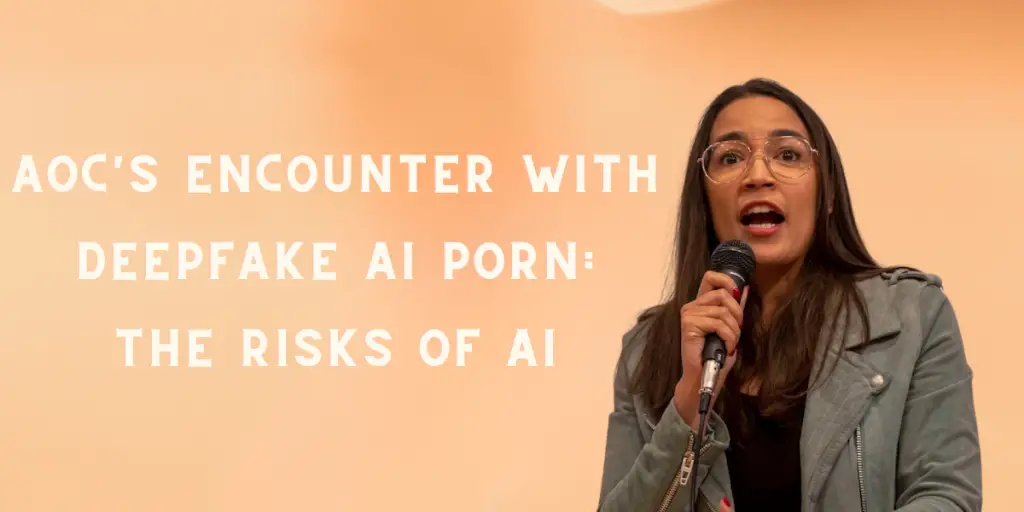AOC's Encounter with Deepfake AI Porn: the Risks of AI

In the realm of digital manipulation, the emergence of deepfake AI poses unprecedented threats to privacy and security. Recent incidents involving Rep. Alexandria Ocasio-Cortez (AOC) encountering deepfake AI pornography shed light on the urgent need to address these risks.Let’s delve into the intricacies of this issue and explore its implications.
Table of Contents
What is Deepfake AI Pornography?
Deepfake AI pornography represents a troubling intersection of technology and exploitation, where individuals’ faces are superimposed onto explicit content without their consent, often with the intent to degrade or humiliate them. Leveraging powerful artificial intelligence algorithms, these manipulative videos and images blur the lines between reality and fabrication, making it increasingly difficult to discern authentic media from digitally altered content.
At its core, deepfake AI pornography exploits the vulnerabilities of digital media, enabling malicious actors to weaponize technology for nefarious purposes. By seamlessly integrating individuals’ likenesses into explicit scenarios, perpetrators of deepfake AI pornography not only violate their victims’ privacy and autonomy but also inflict lasting psychological trauma. This form of digital abuse highlights the urgent need for robust regulatory measures and technological interventions to combat the proliferation of deepfake AI and protect individuals from its harmful consequences.
What is AOC's Response to Deepfake AI?
In the wake of encountering deepfake AI pornography, Rep. Alexandria Ocasio-Cortez (AOC) has responded with resilience and advocacy, shedding light on the profound emotional toll and broader societal implications of such malicious content. Let’s delve deeper into AOC’s response to deepfake AI and its significance.
Bravery in Adversity
AOC’s response to discovering deepfake AI pornography depicting her has been marked by courage and resilience. Despite the emotional distress caused by the violation of her privacy and dignity, she has chosen to confront the issue head-on, refusing to be silenced by the perpetrators’ malicious intent.
Advocacy for Victims
AOC’s experience has fueled her advocacy for victims of deepfake AI and similar forms of digital exploitation. By sharing her story publicly, she aims to raise awareness about the prevalence and harms of deepfake content, while also advocating for policy measures to address the root causes of this phenomenon.
Highlighting Emotional Trauma
AOC has candidly discussed the emotional trauma and distress caused by encountering deepfake AI pornography. Her willingness to speak openly about the psychological impact of such violations serves to humanize the issue and underscore the urgent need for support and resources for victims.
How Does Deepfake AI Impact Public Figures?
The emergence of deepfake AI has ushered in a new era of digital manipulation, posing significant challenges and risks for public figures. Let’s explore in detail how deepfake AI impacts public figures and the broader implications of this phenomenon.

Emotional Distress and Psychological Harm
Public figures, including politicians, celebrities, and activists, are vulnerable to experiencing profound emotional distress and psychological harm when confronted with deepfake AI content. The unauthorized manipulation of their likeness in explicit or defamatory contexts can inflict lasting trauma, undermining their sense of agency and autonomy.
Damage to Reputation and Credibility
The circulation of deepfake AI content can tarnish the reputation and credibility of public figures, leading to unwarranted scrutiny, public backlash, and even legal consequences. False narratives perpetuated through manipulated media can erode public trust and undermine the integrity of individuals’ professional and personal lives.
Challenges in Legal Remedies
Public figures encountering deepfake AI face significant challenges in seeking legal recourse or protection. Existing laws and regulations often struggle to keep pace with the rapid advancements in technology, creating loopholes that perpetrators exploit to evade accountability. As a result, public figures may find themselves navigating complex legal landscapes with limited avenues for redress.
What is the Issue of Deepfake AI?

The issue of deepfake AI encompasses a wide array of challenges and ethical considerations that arise from the manipulation of digital content using artificial intelligence technologies. Let’s delve deeper into the multifaceted nature of the issue.
Privacy Violation
Deepfake AI poses a significant threat to individuals’ privacy rights by enabling the unauthorized manipulation of their likeness in videos and images. This violation of privacy can have profound consequences, including reputational harm, emotional distress, and the erosion of trust in digital media.
Misinformation and Disinformation
The proliferation of deepfake content exacerbates the spread of misinformation and disinformation online. By creating realistic but fabricated media, perpetrators can deceive and manipulate audiences, leading to confusion, polarization, and societal unrest. Deepfake AI challenges the fundamental principles of truth and authenticity in the digital age.
Erosion of Trust in Media
The prevalence of deepfake content undermines trust in traditional and digital media sources, making it increasingly difficult for audiences to discern fact from fiction. As deepfake technology becomes more sophisticated and accessible, the credibility of visual evidence and audio recordings may be called into question, leading to a crisis of trust in information sources.
Legal and Regulatory Challenges
Current legal frameworks struggle to keep pace with the rapid advancements in deepfake AI technology. The absence of clear regulations governing the creation, distribution, and detection of deepfake content creates legal ambiguity and challenges in holding perpetrators accountable. Addressing the legal and regulatory gaps surrounding deepfake AI requires international cooperation and collaboration among policymakers, law enforcement agencies, and tech companies.
Also read:The Taylor Swift AI Outrage: Fans Rally Against Deepfake Dilemma
Why Does Deepfake AI Appear?
The emergence of deepfake AI represents a convergence of technological advancements, societal trends, and individual motivations that have fueled its proliferation. Let’s delve deeper into the underlying factors contributing to the rise of deepfake AI.
Advancements in Artificial Intelligence Technology
Deepfake AI exploits advancements in machine learning, particularly in the field of generative adversarial networks (GANs) and deep learning algorithms. These technologies enable the creation of highly realistic synthetic media by analyzing and synthesizing large datasets of visual and audio content.
Accessibility of Tools and Resources
The democratization of AI tools and resources has made deepfake technology increasingly accessible to individuals with varying levels of technical expertise. Open-source software, online tutorials, and pre-trained models have lowered the barriers to entry, enabling amateur creators to generate deepfake content with relative ease.
What Challenge Does AI Bring?
As artificial intelligence (AI) continues to advance at a rapid pace, it brings forth a myriad of challenges that require careful consideration and proactive solutions. Let’s delve into the multifaceted challenges posed by AI and explore their implications across various domains
Ethical Dilemmas and Moral Considerations
AI technologies raise complex ethical dilemmas surrounding issues such as privacy, consent, bias, and accountability. The use of AI in decision-making processes, ranging from hiring practices to criminal justice systems, raises concerns about fairness, transparency, and unintended consequences. Moreover, the potential for AI to perpetuate or exacerbate existing social inequalities underscores the need for ethical frameworks that prioritize equity and justice.
Technological Complexity and Security Risks
The complexity of AI algorithms and systems introduces new vulnerabilities and security risks that can be exploited by malicious actors. From adversarial attacks and data breaches to the manipulation of AI-generated content, the proliferation of AI poses threats to cybersecurity, privacy, and digital infrastructure. As AI becomes more pervasive, securing systems against emerging threats requires continuous innovation and collaboration across interdisciplinary fields.
Challenges in Transparency and Explainability
The opacity of AI algorithms and decision-making processes raises concerns about transparency, accountability, and bias mitigation. As AI systems make increasingly consequential decisions in areas such as healthcare, finance, and criminal justice, there is a growing demand for explainable AI that enables users to understand and trust the rationale behind algorithmic outcomes. Achieving transparency and accountability in AI development and deployment is essential for building trust and mitigating risks.
How to Solve AI Problems Like Deepfake?
In the face of the evolving challenges posed by artificial intelligence (AI), particularly the proliferation of deepfake content, it becomes imperative to devise comprehensive strategies to mitigate its harmful impacts. Let’s explore a range of approaches to address AI problems like deepfake.
Enhance Regulation and Governance
- Implement Robust Legal Frameworks: Governments must collaborate internationally to enact comprehensive regulations governing the creation, distribution, and detection of deepfake content. These frameworks should include clear guidelines for ethical AI use and impose strict penalties for malicious activities.
- Promote Transparency and Accountability: Platforms hosting user-generated content should implement transparent content moderation policies. By providing users with tools to identify and report deepfake content, platforms can foster accountability and mitigate the spread of malicious material.
- Foster International Collaboration: International cooperation is essential to address the global nature of deepfake AI. Governments, industry stakeholders, and civil society organizations must collaborate to share best practices, resources, and technological solutions for combating deepfake threats.
Invest in Research and Development
- Develop AI Detection Tools: Investment in research and development is crucial to advancing AI detection technologies capable of identifying deepfake content accurately and efficiently. By leveraging machine learning algorithms and image analysis techniques, researchers can enhance the capabilities of detection tools to keep pace with evolving deepfake techniques.
- Explore Blockchain Solutions: Blockchain technology holds promise for enhancing the authenticity and traceability of digital content. By leveraging blockchain-based solutions, such as digital watermarking and content certification, stakeholders can verify the authenticity of media and mitigate the spread of deepfake content.
- Support Interdisciplinary Research: Interdisciplinary collaboration between computer scientists, psychologists, and social scientists is essential to understanding the societal impacts of deepfake AI and developing effective mitigation strategies. By combining technical expertise with insights from diverse disciplines, researchers can develop holistic approaches to address the multifaceted challenges of deepfake AI.
Enhance Regulation and Governance
- Implement Robust Legal Frameworks: Governments worldwide should collaborate to enact comprehensive regulations that address the creation, distribution, and consumption of deepfake content. These regulations should outline clear guidelines for the ethical use of AI technologies while imposing strict penalties for malicious activities.
- Promote Transparency and Accountability: Establish mechanisms to hold creators and disseminators of deepfake content accountable for their actions. Transparency requirements for platforms hosting deepfake content can help users discern between authentic and manipulated media.
- Develop AI Ethics Standards: Foster dialogue among policymakers, technologists, ethicists, and civil society to establish ethical guidelines for AI development and deployment. These standards should prioritize principles such as fairness, transparency, and accountability to mitigate the risks associated with deepfake AI.
Foster Collaboration and Industry Responsibility
- Forge Partnerships Across Sectors: Foster collaboration between governments, tech companies, academia, and civil society to develop holistic solutions to the deepfake challenge. Multi-stakeholder initiatives can leverage diverse expertise and resources to address the complex nature of AI-driven threats.
- Encourage Responsible AI Development: Tech companies should prioritize responsible AI development practices that prioritize user safety and well-being. This includes implementing safeguards against the misuse of AI technologies and promoting ethical design principles throughout the development lifecycle.
- Establish Content Moderation Standards: Platforms hosting user-generated content must implement robust content moderation policies to prevent the dissemination of harmful deepfake material. Automated tools, coupled with human oversight, can help identify and remove illicit content while preserving freedom of expression.
Conclusion
The proliferation of deepfake AI pornography underscores the urgent need for comprehensive measures to address the risks posed by advancing technology. AOC’s experience highlights the profound impact of such manipulative content on individuals and society at large. By fostering collaboration between policymakers, technologists, and educators, we can mitigate the threats posed by deepfake AI and safeguard against its harmful consequences.
Deepfake AI pornography, exemplified by the traumatic experiences of public figures like Alexandria Ocasio-Cortez, underscores the urgent need for comprehensive measures to address the risks posed by advancing technology. Through a combination of regulatory frameworks, technological solutions, and media literacy initiatives, we can combat the proliferation of deepfake AI and safeguard against its harmful consequences.

